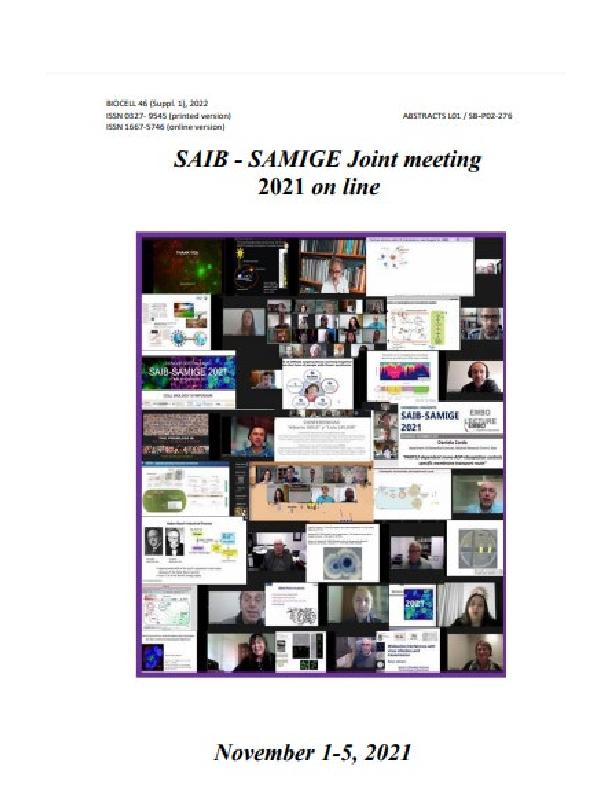Evento
Inflammatory injury affects retinal pigment epithelium cells phagocytic processes: The role of canonical phospholipase D isoforms
Tenconi, Paula Estefania ; Bermúdez, Vicente
; Bermúdez, Vicente ; Asatryan, A.; Mukherjee, P. K.; Giusto, Norma Maria
; Asatryan, A.; Mukherjee, P. K.; Giusto, Norma Maria ; Bazan, Nicolás Guillermo; Mateos, Melina Valeria
; Bazan, Nicolás Guillermo; Mateos, Melina Valeria
 ; Bermúdez, Vicente
; Bermúdez, Vicente ; Asatryan, A.; Mukherjee, P. K.; Giusto, Norma Maria
; Asatryan, A.; Mukherjee, P. K.; Giusto, Norma Maria ; Bazan, Nicolás Guillermo; Mateos, Melina Valeria
; Bazan, Nicolás Guillermo; Mateos, Melina Valeria
Tipo del evento:
Reunión
Nombre del evento:
LVII Annual Meeting of the Argentine Society for Biochemistry and Molecular Biology Research and XVI Annual Meeting of the Argentinean Society for General Microbiology
Fecha del evento:
01/11/2021
Institución Organizadora:
Sociedad Argentina de Investigación Bioquímica y Biología Molecular;
Sociedad Argentina de Microbiología General;
Título de la revista:
Biocell
Editorial:
Tech Science Press
ISSN:
0327-9545
e-ISSN:
1667-5746
Idioma:
Inglés
Clasificación temática:
Resumen
Phospholipases D (PLD) 1 and 2 hydrolyze phosphatidylcholine (PC) to generate choline and phosphatidic acid (PA), which can be further dephosphorylated to diacylglycerol (DAG). DAG and PA can modulate the activity of several proteins involved in cell signaling events, such as protein kinases C and the mTOR (mammalian target of rapamycin), among others. Inflammation is a common factor in the pathogenesis of retinal diseases that eventually end in vision loss, such as age-related macular degeneration (AMD) and diabetic retinopathy (DR). Our previous studies demonstrated for the first time the participation of PLD1 and PLD2 in the inflammatory response and the autophagic process of retinal pigment epithelium (RPE) cells exposed to lipopolysaccharide (LPS) and high glucose (HG) concentrations. The aim of the present work was to further study the role of the PLD pathway in the phagocytic processes of RPE cells. Human RPE cell lines ARPE-19 and ABC (a novel human RPE cell line that spontaneously arose from a primary cell culture) were used. LPS (25 μg/ml) or HG (33 mM) were used to induce the inflammatory response of RPE cells. pHrodo™ Red E. coli BioParticles® and bovine photoreceptor outer segments (POS) were used to evaluate the non-specific and specific phagocytosis, respectively. Western blot (WB) and fluorescence microscopy analysis were performed. WB showed that both classical PLD isoforms are expressed in ABC cells. Using PLD1 and PLD2 siRNA, we were able to partially decrease the expression of PLD1 (by 42 %) and PLD2 (by 30 %). Since PLD-generated PA activates mTORC1, the main inhibitor of autophagy initiation, we studied the effect of classical PLD silencing on mTOR activation. To this end, WB assays were performed in order to study mTOR downstream effector S6 kinase (S6K) activation (phosphorylation). Our results show that in ABC cells transfected with PLD1 and PLD2 siRNA, S6K activation was reduced by 34 %. This result is in accordance with the increased autophagic process induced by PLD1 and PLD2 pharmacological inhibitors, as we previously observed in D407 and ARPE-19 RPE cells. In ARPE-19 cells, HG and LPS exposure significantly reduced pHrodo bioParticles and POS phagocytosis. Since the PLD pathway was shown to modulate the phagocytic process in macrophages, we analyzed the role of both PLDs in RPEphagocytic processes. PLD1 and PLD2 pharmacological inhibitors did not affect non-specific phagocytosis under basal conditions. In line with this, PLD1 and PLD2 silencing did not significantly affect basal POS phagocytosis by ABC cells. Our results demonstrate the expression of classical PLD isoforms in a new RPE cell line and their role in the modulation of the mTOR/S6K pathway. Further experiments are needed to fully elucidate the role of PLD1 and 2 in the phagocytic process of RPE cells exposed to inflammatory conditions. Our findings contribute to the knowledge of the molecular bases of retinal inflammatory and degenerative diseases.
Palabras clave:
RETINAL PIGMENT EPITHELIUM
,
PHOSPHOLIPASES D
,
INFLAMMATION
,
PHAGOCYTOSIS
Archivos asociados
Licencia
Identificadores
Colecciones
Eventos(INIBIBB)
Eventos de INST.DE INVEST.BIOQUIMICAS BAHIA BLANCA (I)
Eventos de INST.DE INVEST.BIOQUIMICAS BAHIA BLANCA (I)
Citación
Inflammatory injury affects retinal pigment epithelium cells phagocytic processes: The role of canonical phospholipase D isoforms; LVII Annual Meeting of the Argentine Society for Biochemistry and Molecular Biology Research and XVI Annual Meeting of the Argentinean Society for General Microbiology; Virtual; Argentina; 2021; 169-169
Compartir



